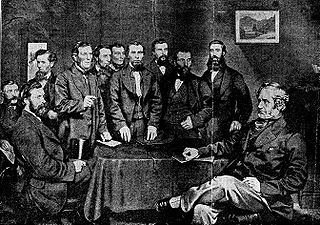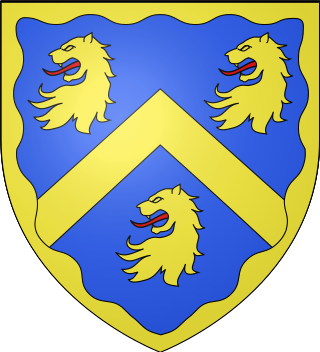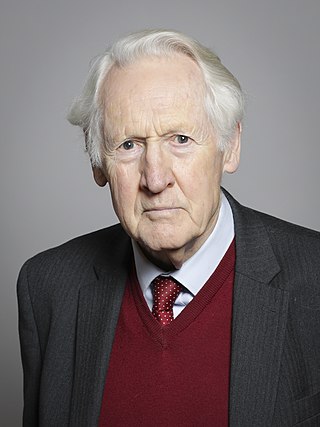Related Research Articles

The Peerage Act 1963 is an Act of the Parliament of the United Kingdom that permits women peeresses and all Scottish hereditary peers to sit in the House of Lords and allows newly inherited hereditary peerages to be disclaimed.

Viscount Hailsham, of Hailsham in the County of Sussex, is a title in the Peerage of the United Kingdom. It was created in 1929 for the lawyer and Conservative politician Douglas Hogg, 1st Baron Hailsham, who twice served as Lord High Chancellor of the Great Britain. He had already been created Baron Hailsham, of Hailsham in the County of Sussex, in 1928, also in the Peerage of the United Kingdom. Hogg was the son of the merchant and philanthropist Quintin Hogg, seventh son of Sir James Hogg, 1st Baronet, whose eldest son James McGarel-Hogg, 2nd Baronet was created Baron Magheramorne in the Peerage of the United Kingdom in 1887.

Marquess of Ailsa, of the Isle of Ailsa in the County of Ayr, is a title in the Peerage of the United Kingdom. It was created on 10 September 1831 for Archibald Kennedy, 12th Earl of Cassilis. The title Earl of Cassilis had been created in 1509 for the 3rd Lord Kennedy. This title had been created in the Peerage of Scotland in 1457. The 1st Marquess had been created Baron Ailsa in the Peerage of the United Kingdom on 12 November 1806.

Earl of Durham is a title in the Peerage of the United Kingdom. It was created in 1833 for the Whig politician and colonial official John Lambton, 1st Baron Durham. Known as "Radical Jack", he played a leading role in the passing of the Great Reform Act of 1832. As Governor General of British North America, he was the author of the famous Report on the Affairs of British North America, known in Canada as the Durham Report. He had already been created Baron Durham, of the City of Durham and of Lambton Castle in the County Palatine of Durham, in 1828. He was created Viscount Lambton at the same time that he was raised to the earldom. These titles are also in the Peerage of the United Kingdom.

Viscount Thurso, of Ulbster in the County of Caithness, is a title in the Peerage of the United Kingdom. It was created on 11 June 1952 for the Scottish Liberal politician and former Secretary of State for Air, Sir Archibald Sinclair, 4th Baronet. His son, the second Viscount, served as Lord Lieutenant of Caithness from 1973 to 1995.
Viscount Camrose, of Hackwood Park in the County of Hampshire, is a title in the Peerage of the United Kingdom. It was created on 20 January 1941 for the prominent newspaper magnate William Berry, 1st Baron Camrose. He had previously received the award of Baronet, of Long Cross in the County of Surrey, in the Baronetage of the United Kingdom, on 4 July 1921, and was created Baron Camrose, of Long Cross in the County of Surrey, on 19 June 1929, in the Peerage of the United Kingdom. His second son, the third Viscount, disclaimed the peerages in 1995 on succeeding his elder brother. However, he had already been created a life peer as Baron Hartwell, of Peterborough Court in the City of London, on 19 January 1968. On his death in 2001 the life peerage became extinct while he was succeeded in the other titles by his eldest son, the fourth Viscount. The first three Viscounts all headed The Daily Telegraph at one point, the first having purchased it from Harry Levy-Lawson, 1st Viscount Burnham, but in the 1980s they lost control to Conrad Black.

Baron Lilford, of Lilford in the County of Northampton, is a title in the Peerage of Great Britain. It was created in 1797 for Thomas Powys, who had previously represented Northamptonshire in the House of Commons. His grandson, the third Baron, served as a Lord-in-waiting from 1837 to 1841 in the Whig administration of Lord Melbourne. He was succeeded by his son, the fourth Baron, an ornithologist.
Baron Gainford, of Headlam in the County Palatine of Durham, is a title in the Peerage of the United Kingdom. It was created on 3 January 1917 for the Liberal politician Jack Pease, a member of the Darlington Pease family. He notably served as President of the Board of Education from 1911 to 1915. Pease was the second son of Sir Joseph Pease, 1st Baronet, and the grandson of Joseph Pease, while Arthur Pease was his uncle and Sir Arthur Pease, 1st Baronet, Beaumont Pease, 1st Baron Wardington, and Herbert Pease, 1st Baron Daryngton, were his first cousins. The third baron was a former member of the London County Council and of the Greater London Council. As of 2013 the title is held by his younger brother, the fourth baron, an architect and town planner; County Planning Officer for Ross and Cromarty 1967–1975 and Scottish Office Inquiry Reporter 1978–1993.
Baron Altrincham, of Tormarton in the County of Gloucester, is a title in the Peerage of the United Kingdom. It was created on 1 August 1945 for the politician Edward Grigg. His son, the second Baron, was a politician, journalist, historian and writer. Soon after the passage of the Peerage Act 1963 on 31 July 1963, he disclaimed the title for life. As of 2020 the title is held by his nephew, who succeeded as 4th Baron on his father's death in that year.
Baron Kennet, of the Dene in the County of Wiltshire, is a title in the Peerage of the United Kingdom. It was created in 1935 for the journalist and politician Sir Hilton Young. He was the youngest son of Sir George Young, 3rd Baronet, of Formosa Place. He was succeeded by his son, the second Baron. He was a writer and politician. As of 2010 the title is held by his son, the third Baron, who succeeded in 2009. As a great-grandson of Sir George Young, 3rd Baronet, of Formosa Place, he is also in remainder to this title.
Baron Silkin, of Dulwich in the County of London, is a title in the Peerage of the United Kingdom. It was created on 4 July 1950 for the solicitor and Labour politician Lewis Silkin. The peerage was disclaimed by both his eldest son, the second Baron, and the latter's nephew, the third Baron. When the third Baron disclaimed the title in 2002, the barony of Silkin became the first peerage ever to be disclaimed twice; and the only disclaimer since the House of Lords Act 1999
Baron Sanderson of Ayot, of Welwyn in the County of Hertford, is a title in the Peerage of the United Kingdom. It was created in 1960 for the businessman and public servant, Basil Sanderson. He was the son of the shipping magnate Harold Arthur Sanderson, general manager of the White Star Line, and himself was chairman and president of the Shipping Federation. On Lord Sanderson of Ayot's death in 1971 he was succeeded by his elder twin son Alan Lindsay Sanderson. However, he disclaimed the peerage for life the same year.

Baron Penrhyn is a title that has been created twice. The first creation came in the Peerage of Ireland in 1783 in favour of Richard Pennant, who had previously served as a Member of Parliament for Petersfield and Liverpool. This creation became extinct on his death in 1808. The next creation came in 1866 in the Peerage of the United Kingdom when the Conservative politician Edward Douglas-Pennant was created Baron Penrhyn, of Llandegai in the County of Carnarvon. He had previously represented Carnarvon in the House of Commons and also served as Lord Lieutenant of Caernarvonshire. He was granted the estate of his father-in-law on the condition that he accepted his wife's maiden name, Pennant. Lord Penrhyn was the younger brother of The 17th Earl of Morton. In 1833 he had married Juliana Isabella Mary Pennant, eldest daughter and co-heiress of George Hay Dawkins-Pennant of Penrhyn Castle and in 1841 he assumed by Royal licence the additional surname of Pennant.
Baron Monkswell, of Monkswell in the County of Devon, is a title in the Peerage of the United Kingdom. It was created in 1885 for the lawyer and Liberal politician Sir Robert Collier. His eldest son, the second Baron, served as Under-Secretary of State for War in 1895 in the Liberal administration of Lord Rosebery. His grandson, the fourth Baron, disclaimed the peerage on 7 April 1964. He had earlier been a member of the Essex County Council. As of 2020 the title is held by his grandson, the sixth Baron, who succeeded in that year.

Baron Merthyr, of Senghenydd in the County of Glamorgan, is a title in the Peerage of the United Kingdom. It was created in 1911 for the Welsh coal mining magnate Sir William Lewis, 1st Baronet. He had already been created a baronet, of Nantgwyne in the County of Glamorgan, in 1896. The barony is named after the town of Merthyr Tydfil, where Lewis was born. Lord Merthyr's grandson, the third Baron, was Chairman of Committees in the House of Lords from 1957 to 1965 and a Deputy Speaker from 1957 to 1974. The latter was succeeded by his son, the fourth Baron. He disclaimed the peerage for life on 26 April 1977, three weeks after succeeding his father. He did not use his title of baronet either. He died on 5 August 2015.
Baron Calverley, of the City of Bradford in the West Riding of the County of York, is a title in the Peerage of the United Kingdom. It was created in 1945 for the Labour politician George Muff. He had previously represented Kingston upon Hull East in the House of Commons. As of 2010 the title is held by his grandson, the third Baron, who succeeded his father in 1971.

Baron Leconfield, of Leconfield in the East Riding of the County of York, is a title in the Peerage of the United Kingdom. It was created in 1859 for Col. George Wyndham (1787–1869). He was the eldest illegitimate son and adopted heir of George Wyndham, 3rd Earl of Egremont (1751–1837), from whom he inherited Petworth House in Sussex, Egremont Castle and Cockermouth Castle in Cumbria and Leconfield Castle in Yorkshire, all formerly lands of Josceline Percy, 11th Earl of Northumberland (1644–1670), inherited by Charles Seymour, 6th Duke of Somerset (1662–1748), on his marriage to the Percy heiress Elizabeth Percy (1667–1722) and inherited as one of the co-heirs of his son Algernon Seymour, 7th Duke of Somerset, 1st Earl of Egremont (1684–1750), by the latter's nephew Sir Charles Wyndham, 4th Baronet (1710–1763), of Orchard Wyndham in Somerset, who inherited by special remainder the earldom of Egremont. The 1st Baron's eldest son, the second Baron, represented West Sussex in the House of Commons as a Conservative. He was succeeded by his eldest son, the third Baron, who served as Lord Lieutenant of Sussex from 1917 to 1949. The latter's nephew, the sixth Baron, served as Private Secretary to Prime Minister Harold Macmillan from 1957 to 1963. In 1963, four years before he succeeded his father in the barony of Leconfield, the Egremont title held by his ancestors was revived when he was raised to the peerage as Baron Egremont, of Petworth in the County of Sussex. As of 2017 the titles are held by his son, the seventh Baron. Known as Max Egremont, he is a biographer and novelist.

Lewis Silkin, 1st Baron Silkin CH, was a British Labour Party politician.

James Alexander Douglas-Hamilton, Baron Selkirk of Douglas, is a Scottish Conservative Party politician who served as Member of Parliament for Edinburgh West and then as a Member of the Scottish Parliament (MSP) for the Lothians region. Between 1997 and 2023 he was a member of the House of Lords as a life peer.
George Archibald, 1st Baron Archibald CBE was a British Labour politician.
References
- ↑ "No. 38664". The London Gazette . 12 July 1949. p. 3408.